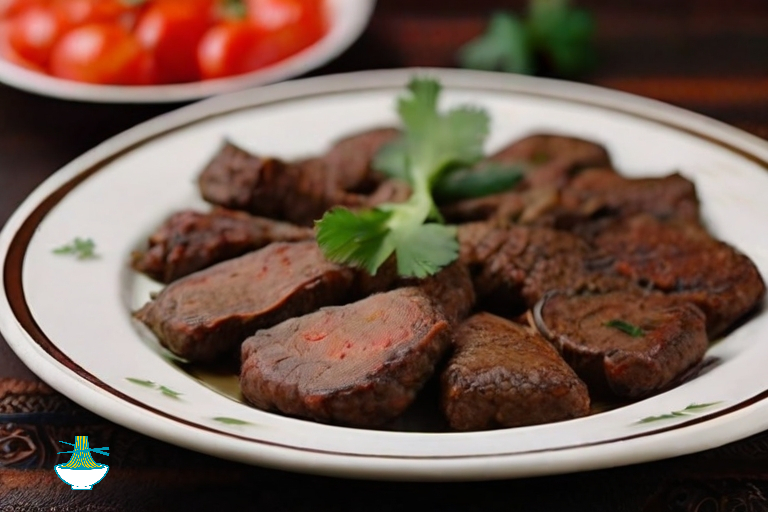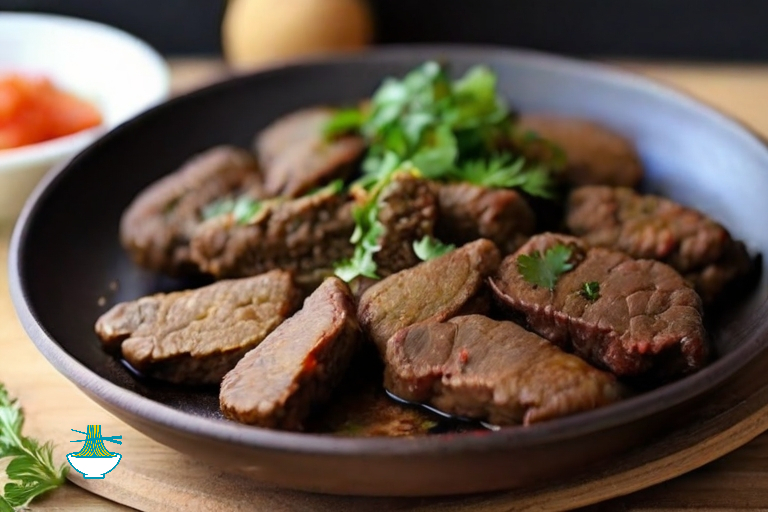Armenian Tjvjik, a dish steeped in history and tradition, offers a unique exploration of flavors and cultural significance. Known for its distinctive taste and intricate preparation, Tjvjik embodies the essence of Armenian culinary heritage, serving as a connection between past and present generations. This dish not only delights the senses but also provides a rich tapestry of nutritional benefits, including essential vitamins and minerals that promote health and well-being. The careful blend of spices used in Tjvjik brings out its full flavor profile, while also contributing to digestive health and immune support. However, it’s important to note that, like many rich and flavorful dishes, Tjvjik should be enjoyed in moderation, as its high fat content can be a consideration for those mindful of calorie intake. With each bite, Armenian Tjvjik invites us to celebrate the resilience of a culture, offering a glimpse into the culinary heart of Armenia.

Ingredients:
- 1 pound lamb or beef, cut into small cubes
- 1 large onion, finely chopped
- 2 cloves garlic, minced
- 1 cup cherry tomatoes, halved
- 1 cup bell peppers, diced (mix of red, green, and yellow)
- 1 cup eggplant, diced
- 1 cup zucchini, diced
- 1/2 cup vegetable oil
- 1 tablespoon tomato paste
- 1 teaspoon paprika
- 1 teaspoon ground cumin
- 1 teaspoon dried oregano
- Salt and pepper to taste
- Fresh parsley, chopped (for garnish)
Instructions:
1. Heat vegetable oil in a large skillet or pot over medium heat.
2. Add the chopped onions and minced garlic to the heated oil. Sauté until the onions are translucent and the garlic is fragrant.
3. Add the diced lamb or beef to the skillet and cook until browned on all sides.
4. Stir in the tomato paste, paprika, cumin, dried oregano, salt, and pepper. Mix well to coat the meat with the spices.
5. Add the cherry tomatoes, bell peppers, eggplant, and zucchini to the skillet. Stir to combine the ingredients.
6. Cover the skillet and let the mixture simmer over low to medium heat for about 25-30 minutes, or until the meat is tender and the vegetables are cooked through.
7. Taste and adjust the seasoning as needed.
8. Once cooked, remove the skillet from the heat and let it sit for a few minutes before serving.
9.Garnish the Tjvjik with chopped fresh parsley before serving.
10. Serve the Armenian Tjvjik hot, either on its own or accompanied by a side of rice, bulgur, or flatbread.
Enjoy this flavorful and comforting Armenian dish that reflects the culinary traditions of the region!
Note:While Tjvjik is nutrient-dense and generally healthy, it’s important to be mindful of the high fat and calorie content, especially when consumed in large quantities or frequently. For individuals with certain health conditions, such as high cholesterol or high blood pressure, the dish may need to be enjoyed in moderation. Choosing leaner cuts of meat and reducing the amount of added oil can help mitigate some of these concerns.
Frequently Asked Questions :
1.Can Tjvjik be prepared using another type of meat?
- Yes, Tjvjik can be prepared using various types of meat, such as lamb, beef, or even chicken. The choice of meat depends on personal preference and dietary needs.
2.Can this dish be made vegetarian?
- Absolutely! Tjvjik can be adapted to be vegetarian by replacing the meat with a combination of legumes such as lentils, beans, or chickpeas, along with additional vegetables to enhance flavor and texture.
3.What are some alternatives to vegetable oil in the recipe?
- Alternatives to vegetable oil include olive oil, coconut oil, or even avocado oil. Each option brings a unique flavor profile to the dish and offers various health benefits.
4.What are the best accompaniments to serve with Tjvjik?
- Tjvjik pairs well with rice, bulgur, or flatbreads. Additionally, side dishes such as a fresh salad or yogurt-based dips can complement the rich flavors of the dish.
5.Is Tjvjik suitable for people following a low-fat diet?
- While Tjvjik is flavorful and rich, it can be adapted to lower fat content by using lean meats and reducing the amount of added oil. Swapping vegetable oil for healthier fats, like olive oil, and trimming excess fat from meat can further reduce fat intake.
6.How can the recipe be adjusted for those with onion or garlic sensitivities?
- For those who are sensitive to onion or garlic, both ingredients can be omitted or replaced with alternative flavoring agents like shallots, leek, or a garlic-infused oil.
7.What is the best way to store leftover Tjvjik?
- Leftover Tjvjik should be stored in an airtight container in the refrigerator for up to 3-4 days. It can be reheated on the stovetop or in the microwave, ensuring it is heated thoroughly before consuming.
Health Benefits
- Tjvjik is not only a delicious and comforting dish but also provides several nutritional benefits that support overall health. It is rich in high-quality protein from the meat, which is essential for muscle repair, immune function, and overall body maintenance. The combination of vegetables like tomatoes, bell peppers, eggplant, and zucchini offers a variety of vitamins and minerals, including:
- Vitamin C: Found in tomatoes, bell peppers, and onions, which supports the immune system and promotes healthy skin.
- Fiber: Provided by vegetables such as eggplant and zucchini, aiding in digestion and promoting heart health.
- Antioxidants: The combination of lycopene from tomatoes and other antioxidant-rich spices like paprika and cumin helps reduce inflammation and support cardiovascular health.
Nutritional Values
It's challenging to provide precise nutritional values without specific brand information and cooking methods. However, I can offer estimated values based on typical nutritional content. Keep in mind that these values may vary based on factors such as the type of meat used, the specific brands of ingredients, and the cooking methods employed.
Here are rough estimates per serving (assuming 4 servings):
Lamb or Beef (1 pound):
- Calories: 800-1000 kcal
- Protein: 80-100g
- Fat: 50-70g
- Carbohydrates: 0g
benefits:
- Rich source of high-quality protein, essential for muscle repair and overall body function.
- Provides important nutrients like iron, zinc, and B-vitamins.
Large Onion:
- Calories: 45 kcal
- Protein: 1g
- Fat: 0g
- Carbohydrates: 11g
- Fiber: 3g
benefits:
- Contains antioxidants and anti-inflammatory compounds.
- High in vitamin C and fiber, promoting a healthy immune system and digestive function.
Garlic (2 cloves):
- Calories: 10 kcal
- Protein: 0g
- Fat: 0g
- Carbohydrates: 2g
- Fiber: 0g
benefits:
- Known for its anti-bacterial and anti-viral properties.
- Contains allicin, which may contribute to heart health.
Cherry Tomatoes (1 cup, halved):
- Calories: 30 kcal
- Protein: 1g
- Fat: 0g
- Carbohydrates: 7g
- Fiber: 2g
benefits:
- Excellent source of vitamin C and other antioxidants.
- Contains lycopene, associated with various health benefits including heart health.
Bell Peppers (1 cup, mixed colors):
- Calories: 30 kcal
- Protein: 1g
- Fat: 0g
- Carbohydrates: 7g
- Fiber: 2g
benefits:
- High in vitamin C, supporting immune function.
- Rich in antioxidants, contributing to eye health and reducing inflammation.

Eggplant (1 cup, diced):
- Calories: 20 kcal
- Protein: 1g
- Fat: 0g
- Carbohydrates: 5g
- Fiber: 3g
benefits:
- Contains fiber and antioxidants, promoting digestive health.
- May contribute to heart health and weight management.
Zucchini (1 cup, diced):
- Calories: 20 kcal
- Protein: 1g
- Fat: 0g
- Carbohydrates: 4g
- Fiber: 1g
benefits:
- Low in calories and high in water content, aiding in hydration.
- Good source of vitamins A and C, promoting skin health.
Vegetable Oil (1/2 cup):
- Calories: 960 kcal
- Protein: 0g
- Fat: 108g
- Carbohydrates: 0g
benefits:
- Provides healthy fats, essential for nutrient absorption and brain function.
- Contains vitamin E, an antioxidant that supports skin health.
Tomato Paste (1 tablespoon):
- Calories: 15 kcal
- Protein: 1g
- Fat: 0g
- Carbohydrates: 3g
- Fiber: 1g
benefits:
- Concentrated source of lycopene, with potential benefits for heart health.
- Contains vitamins A and C, supporting vision and immune function.
Paprika (1 teaspoon):
- Calories: 6 kcal
- Protein: 0g
- Fat: 0g
- Carbohydrates: 1g
- Fiber: 1g
benefits:
- Contains antioxidants that may help reduce inflammation.
- May have beneficial effects on metabolism.
Ground Cumin (1 teaspoon):
- Calories: 8 kcal
- Protein: 0g
- Fat: 1g
- Carbohydrates: 1g
- Fiber: 0g
benefits:
- Known for its digestive benefits and anti-inflammatory properties.
- Contains iron, promoting healthy blood.
Dried Oregano (1 teaspoon):
- Calories: 3 kcal
- Protein: 0g
- Fat: 0g
- Carbohydrates: 1g
- Fiber: 0g
benefits:
- Rich in antioxidants and anti-bacterial properties.
- Contains vitamins K and E, supporting bone health and skin integrity.
Salt and Pepper:
- Negligible calorie contribution
Fresh Parsley (for garnish):
- Negligible calorie contribution
Please note that these values are approximations and can vary based on the specific ingredients and cooking methods used. If you have specific dietary requirements or need more precise information, it's recommended to consult with a registered dietitian or use specialized nutritional analysis tools.


Comments